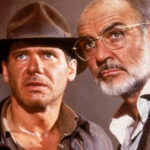

Since its debut in 1968, the “Planet of the Apes” franchise has captivated and intrigued audiences with its dystopian and thought-provoking vision of a society dominated by intelligent apes. Stemming from Pierre Boulle’s novel, the original film directed by Franklin J. Schaffner unleashed a saga that spanned decades and continued to evolve through sequels, remakes, and adaptations across various media.
However, beyond the intricate plots and groundbreaking special effects, the saga is also marked by a series of fascinating curiosities that permeate its production, from intriguing behind-the-scenes stories to remarkable coincidences. In this exploration of the “Planet of the Apes” franchise’s curiosities, we delve into peculiar details that add layers to the appreciation of this iconic cinematic universe.
1 – THE FIRST FILM
The inaugural film of the “Planet of the Apes” franchise emerged in 1968, predating the era of computer-generated imagery and narratives surrounding the rise of primates. Directed by Franklin J. Schaffner and scripted by Michael Wilson and Rod Serling, this film left an indelible mark on cinema, standing out as one of the most lavish productions of its time.
Set in a distant future, the plot unfolds as astronauts find themselves stranded on a seemingly uninhabited planet. However, as they explore further, they uncover a society dominated by intelligent beings resembling evolved apes. Enriched by Jerry Goldsmith’s musical score, the work continues to captivate audiences to this day.
2 – INSPIRATIONS FROM OTHER WORKS
Before hitting the silver screen, “Planet of the Apes” emerged as a literary creation by the renowned French author Pierre Boulle, dating back to 1963. Boulle, in turn, found inspiration in earlier works such as “Gulliver’s Travels,” where the protagonist explores a land governed by horses, and George Orwell’s “Animal Farm.” These influences intertwine skillfully in the narrative, contributing to the complexity and depth of the fictional world Boulle envisioned. Thus, the journey of “Planet of the Apes” transcends cinema, rooted in a rich and diverse literary lineage.
3 – THE BOOK
In Boulle’s original narrative, the storyline diverges considerably from the path taken by the film. The book depicts the journey of three human space explorers who land on a planet orbiting the star Betelgeuse, where large apes stand out as superior and intelligent beings, relegating the human race to a primitive and wild state.
Contrary to the film, Boulle’s text portrays the apes in a highly civilized society, replete with futuristic technology, including cars, helicopters, and giant airplanes. However, the adaptation for cinema faced budgetary challenges, resulting in the simplification of the ape society presented on the big screen.
4 – FILMING CHALLENGES
Among the most distinctive and memorable aspects of “Planet of the Apes” are undoubtedly the extraordinary makeup techniques and practical effects used. Revolutionary for its time, the prosthetics, makeup, and touch-ups required an investment of approximately $1 million, representing about one-fifth of the film’s total budget.
In terms of cost, “Planet of the Apes” ranks among the most expensive productions of the 1960s, with an approximate investment of $5 million, resulting in a financial return of over $30 million, a resounding success.
Considering that the film was shot in the scorching temperatures of the Arizona desert, with incredibly complex makeup and prosthetics, as well as an intricate science fiction plot, it is truly remarkable that it was successfully accomplished.
5 – SEQUELS
Following the release of the 1968 film, four more movies were produced as part of the initial franchise, all completed by 1973—a relatively brief period considering the scope of the saga. “Beneath the Planet of the Apes” premiered in 1970, followed by “Escape from the Planet of the Apes” in 1971, “Conquest of the Planet of the Apes” in 1972, and “Battle for the Planet of the Apes” in 1973.
The first appearance of Caesar occurs in “Escape from the Planet of the Apes” when Zira and Cornelius, the ape scientists from the original film, escape the planet’s nuclear apocalypse using the spacecraft that brought the human crew, thus traveling back in time.
In 1974, Zira and Cornelius become recognized public figures but are soon subjected to torture to reveal information about Earth’s future. They are the parents of Caesar, who is kept secret and, decades later, leads the ape revolution against humans.
6 – A SERIES WAS MADE
The “Planet of the Apes” saga didn’t conclude in 1973. In 1974, a television series inspired by the film was launched, exploring events that possibly preceded the first feature film or followed “Escape from the Planet of the Apes.” However, the show had a limited connection to the film franchise.
In the series, we are introduced to astronauts who land on the planet in the year 3085, about 900 years before the events involving the protagonists of the first film. The timeline of events is not clearly explained, leaving it uncertain whether these events truly precede “Planet of the Apes” or occur after some change in the timeline.
7 – SEVERAL SEQUELS
In 2001, an attempt to recreate the first film was made under the direction of Tim Burton and starring Mark Wahlberg. However, the result was largely forgettable, with the film essentially rehashing the plot of the original, only with a more contemporary aesthetic and enhanced visual effects.
In contrast, in 2011, under the direction of Rupert Wyatt, “Rise of the Planet of the Apes” was released, not as a remake but as a reboot of the franchise. Retaining elements of the original narrative but reinventing them for a more coherent storyline, the film follows the journey of the awakening and rise of the apes on Earth.
The main focus is on the story of Caesar, a character dating back to the third film in the series, exploring his origin, development, and rebellion. The surprising success of the film was a revelation for both the audience and the studio responsible for its production.
In 2014, a sequel titled “Dawn of the Planet of the Apes” was made, and the third film is called “War for the Planet of the Apes,” released in 2017.
The 1968 “Planet of the Apes” franchise not only captivated audiences with its dystopian and intriguing narrative but also sparked a world of curiosities and fascinations that continue to enchant fans to this day. From the revolutionary technical challenges faced during the production of the original film to the various interpretations and reboots over the years, the saga of intelligent apes offers a wealth of details to explore and appreciate. From literary inspirations to cinematic adaptations, the journey through the “Planet of the Apes” universe is a voyage spanning decades and generations, leaving an indelible mark on pop culture and in the hearts of viewers. As we delve into these curiosities, we are reminded not only of the genius behind the cameras but also of the enduring power of a story that continues to challenge our perception of what it means to be human.








